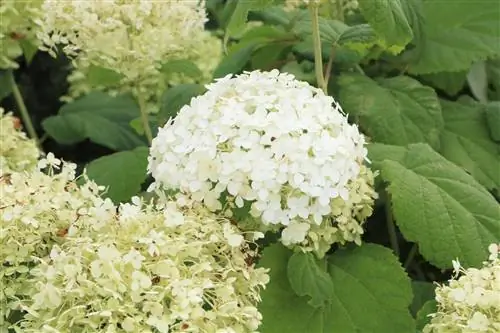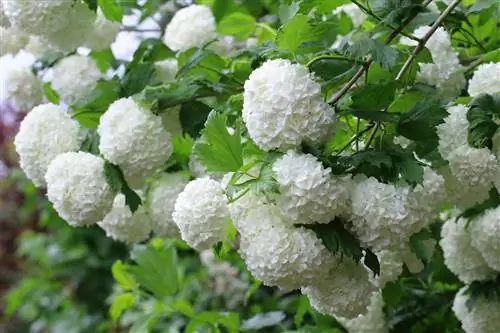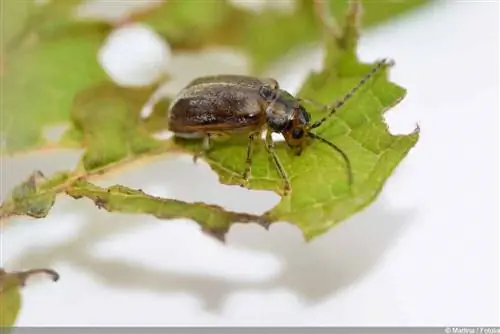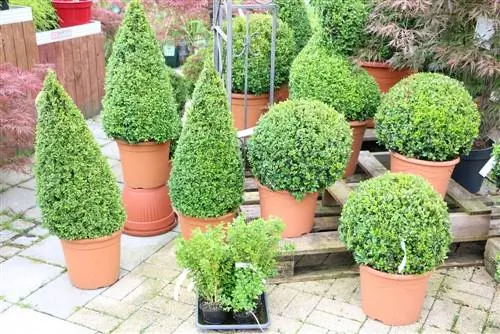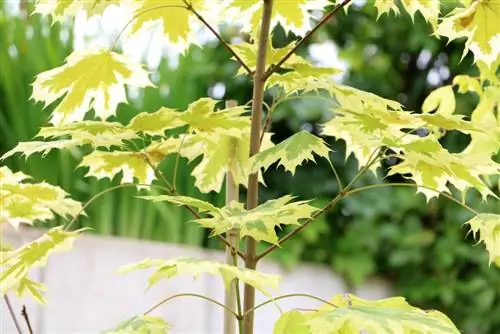- Author admin [email protected].
- Public 2023-12-17 03:39.
- Last modified 2025-06-01 06:48.
Hydrangeas are one of the most popular garden plants and are making a massive comeback recently. Many new varieties have emerged, such as forest hydrangea “Annabelle”, known as snowball hydrangea for its magnificent white flower umbels. Hydrangeas are robust plants that, when properly cared for, delight gardeners with their blooms year after year.
Snowball hydrangea “Annabelle” - A beauty in white
The Latin name of this hydrangea is Hydrangea arborensis - forest hydrangea or tree hydrangea. There are several known cultivars of forest hydrangeas. The “Annabelle” variety is also called snowball hydrangea or simply ball hydrangea for its white (often with some green and pink) spherical flower umbels. The woody bushes grow up to 1.5 m high and usually bloom from May to autumn. Dried umbels also look decorative. The plant is robust and does not require complex care, but some requirements must be taken into account when choosing a location and fertilizing. Possible alternatives to the snowball hydrangea are the “classic” farmer’s hydrangea or a chic cultivated form “Bluebird” with the umbrella-shaped flowers.
Location and soil
The snowball hydrangea “Annabelle” feels particularly comfortable in humus-rich, loose soil. It is therefore advisable to loosen the soil regularly. Partial shade is considered an optimal location for the plant. The plant does not feel comfortable in the shade or in the blazing sun and refuses to bloom.
Tip:
The viburnum hydrangea tolerates several hours of sun per day quite well. To save yourself the trouble of digging, a thick layer of mulch can be applied around the plant. This also protects the soil from drying out.
Care and fertilization
Snowball hydrangea “Annabelle” does not require complex care during the flowering period, but needs to be watered regularly. The plant tolerates soft rainwater or groundwater best, which should be applied directly to the roots. If ball hydrangeas are watered with tap water and it is too hard in the area, it can be softened by adding peat (leave it overnight). Waterlogging quickly leads to rot and must be avoided at all costs. Fertilize with special hydrangea fertilizer; fertilizers for rhododendrons or azaleas are also suitable because the composition is similar. Nitrogen is important for the plant to thrive. Fertilizing once a month between April and October is enough, you should pay attention to the exact dosage.
Tip:
If you want the white ball hydrangea to have a light pink-red shimmer, adding phosphorus (in small quantities) is recommended.
Cutting
So that the heavy flower umbels do not damage the plant due to their weight, the snowball hydrangea “Annabelle” should be cut back regularly. The optimal time is in autumn after the plant has bloomed. How radically the ball hydrangea needs to be cut back depends on the taste of the gardener. In any case, the forest hydrangea can tolerate being cut back to a height of around 15 cm, but it can also easily be 50-70 cm. Of course, it is important to ensure that at least one pair of eyes (preferably more) should remain on each branch. Tip: Dry flower umbels look impressive, but tend to fall off in winter and are then blown around the garden by the wind. It's better to cut it off in November at the latest.
Propagate
When propagating by lowering, the procedure is as follows:
- A shoot is placed in a specially prepared gutter
- The shoot (there can be several shoots at the same time) is weighed down with stones without being separated from the bush
- As soon as the shoot takes root, it can now be cut off and planted in the desired location.
Tip:
Slightly scratching the bark on the sinker accelerates root formation. Propagating the snowball hydrangea from cuttings is also no problem. Here's how to do it:
- Cut off one or two branches, approx. 20 cm long, preferably cutting at an angle at the bottom
- Make sure that cuttings have at least two eyes (preferably more)
- Place cuttings in the growing soil, always keep the substrate moist
- After about a week, the cuttings will form roots and can then be planted in the appropriate location.
Tip:
The optimal time for this type of propagation is early spring.
Wintering
Forest hydrangeas, also the snowball hydrangea “Annabelle”, are hardy and can even tolerate cold temperatures down to -20 °C. A little protection from leaves, sticks and fleece will help the plant survive the winter unscathed - especially if it is windy and with little snow. Mulch is also a great help during wintering, as mulched soils are better protected from frost.
Diseases
Snowball hydrangeas are resilient plants that rarely get sick with proper care. If leaves of “Annabelle” turn yellow, the pH value in the soil being too high or a lack of iron may be responsible. In this case, adding rhododendron soil can help, and hydrangea fertilizer can also help. Powdery mildew is another unpleasant disease that can be combated, for example, with nettle manure, but of course also with fungicides from the garden center. Powdery mildew occurs more frequently during drought, and regular, extensive watering of the hydrangea reduces the risk of being attacked by this fungus.
Tip:
Cut off shoots affected by the fungus (powdery mildew) immediately and do not compost them, but dispose of them as residual waste. Spraying a mixture of water and milk in a ratio of 2:1 helps against powdery mildew, but also against aphids - not just on the ball hydrangea.
Frequently asked questions
Are snowball hydrangeas suitable as container plants?
Yes, lush blooming hydrangeas in large pots look impressive on the terrace. When it comes to potted plants, it is important to pay particular attention to a good water supply and protection from the cold. Hydrangeas can overwinter protected in pots on the terrace, but also feel comfortable in the winter garden and even at room temperatures.
Which plants can ball hydrangeas be best combined with?
The impressive hydrangea also looks beautiful as a solitaire, but can be combined with other hydrangeas in other colors. Forsythia also look effective with hydrangeas, and these plants complement each other, because forsythia are early bloomers, but can also open their yellow flowers in warm temperatures, even in winter. Evergreen rhododendrons emphasize the elegance of the delicate hydrangea.
What you should know about the snowball hydrangea in brief
Care
- The viburnum hydrangea needs a nutrient-rich, humus-rich, moist soil that should be acidic to neutral.
- In autumn, after flowering, the snowball hydrangea can be cut back. It then branches better and becomes denser.
- The best way to fertilize is with slow-release fertilizer.
- Pruning can also be done in spring; the plant usually sprouts without any problems. You can trim it to approx. 10 cm.
- The flowers decorate the hydrangea well into autumn and even look good when covered in hoarfrost.
Pouring
Hydrangeas in pots should never dry out. To improve the microclimate in the bucket, they should be placed on coasters filled with expanded clay or gravel and water. Hydrangeas also like spraying in summer. A thick layer of gravel or grit on the bottom of the bucket prevents the water from pooling. Repotting takes place approximately every two years.
Propagate
- Hydrangeas are propagated by cuttings. To do this, take a shoot tip without a flower because it takes too much energy from the cutting.
- You cut the cutting just below a node. There are cells there that are able to form roots.
- The stem should not be pressed when cutting. All but three to four pairs of leaves are removed.
- Rooting powder helps so that the roots on the cutting develop faster and better.
- You should always use new soil, because fungal infections are the greatest danger to the cuttings.
- The soil should only be kept moderately moist. The best time for cuttings is in spring or autumn.
Coloring
The blue color of the hydrangea depends not only on the variety, but also on the pH of the soil and the aluminum content. Plants only turn blue on acidic soils. They need a pH of 4 to 4.5 to absorb aluminum. A higher value binds the aluminum. If you want to turn normal-colored hydrangeas into blue ones, you have to make sure that they are also blue-flowering varieties. Only these can be discolored because they contain the dye delphinidin. This causes the blue color with the help of fertilizers containing aluminum. As a rule, discoloration can only be achieved in light, well-drained soils. It usually doesn't work on heavy soils.

